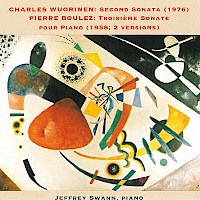Second Piano Sonata
- Instrumentation
- Pf
- Year
- 1976
- Duration
- 28:00
For the greater part of the century after its development, the Sonata was the principal vehicle of large-scale piano composition. From C.P.E. Bach through Haydn, Mozart, Beethoven, and Schubert, the form underwent considerable evolution and metamorphosis but retained its preeminence in the compositional hierarchy. In the 19th century, however, the Sonata’s importance became more irregular—probably because those composers who continued to use it were more or less consciously linking themselves with the Classical tradition. Nevertheless certain works, especially the Liszt Sonata, are of great importance and introduce major innovations. In the early 20th century, interest in the Sonata was momentarily revived, largely as an expression of neoclassicism and the restoration of an form viewed as archaic. In the period since World War II, however, a few composers have taken up the challenge of writing major Sonatas, giving the form new definition and significance.
The American composer Charles Wuorinen has to date written three Sonatas for piano. The present work, Second Sonata, was composed in 1976 and commissioned by me as part of a grant for a Bicentennial Piano Series of the Washington Performing Arts Society and premiered in 1977 at the Kennedy Center. I chose Mr. Wuorinen for this commission in part because of his unique combination of intellectual rigor and wide emotional range, and in part because I knew of his interest in large-scale forms and in his ability to write brilliantly and originally for the piano. Indeed, as an anecdotal side note I might mention an occasion when I half-jokingly requested Mr. Wuorinen to give the work a substantial and obvious conclusion — not a shaggy-dog ending was the term I believe I used. The listener will hear that in the entire repertoire there can be few less inconspicuous endings!
The Second Sonata is a transitional work within Wuorinen’s oeuvre. In particular it is less austere, less compositionally rigorous, less rhythmically and texturally complex than many earlier works, notably the Sonata No. 1. On the other hand, its fluid, jazz-like passages with tonal connotations suggest later works such as The Blue Bamboula and Capriccio. The resulting pianistic style with contrasting dense polyphony, complex passage work, and block chords is particularly rich and full of variety and an idiosyncratic virtuosity.
The title page contains a thumbnail description of the work: “Second Sonata for Piano that is a Triple Discourse, containing a Prelude, Three Movements Intermixed, a pause; The Same Resumed; and the Whole Completed with a Postlude.” The three movements and Prelude each have easily recognizable melodic and motivic material as well as a constant tempo which relates clearly to the tempi of the other sections. Indeed, the nature of the three movements I follows the traditional Classical outline: the first is highly rhythmically I charged and dynamic, the second slow and lyrical, the third brilliant and scherzando. What is unique is that I each of the movements interrupts the others, creating a complex labyrinthian form in which much excitement is generated by the return of familiar material in unexpected moments. This is particularly true in the last occurrence of Movement Three where material from the Prelude arrives in the very different tempo of that movement. In a similar manner, much of the excitement of the Postlude derives from the return of earlier material in a faster tempo—or at least in an environment containing faster note values.
The actual construction runs as follows: Prelude, Movement One, Movement Three, Movement One, Movement Two, Prelude, Movement Two, Movement One, Movement Three, Movement One, Movement Two, Movement One, Movement three, Postlude. The Prelude contains the basic cornpositional materials for the whole work. The return of the Prelude in the very center of the piece marks the first climax and is followed by a notable pause. The movements interrupt each other but only begin to intermingle material in the second halt of the piece. This process of gradual amalgamation is one of the exciting elements of the work.
-From a program note by Jeffrey Swann © 1993 (Music & Arts CD-763, Piano Sonatas of Wuorinen and Boulez)
"Charles Wuorinen's Sonata No, 2 for piano, which received its premiere performance Saturday afternoon at the Kennedy Center, should add significantly to the composer's already substantial reputation. It is music clearly contemporary in form but not modem for the sake of modernity, often angular in its melodic lines but nonetheless emotionally expressive, ingenious in the way it uses silences as well as the more substantial dynamic resources of the piano. The first performance made two things quite clear: The sonata requires considerable technique to achieve its proper effect, and the pianist Jeffrey Swann, who played it at the Kennedy Center, has all the technique it demands." The Washington Post

